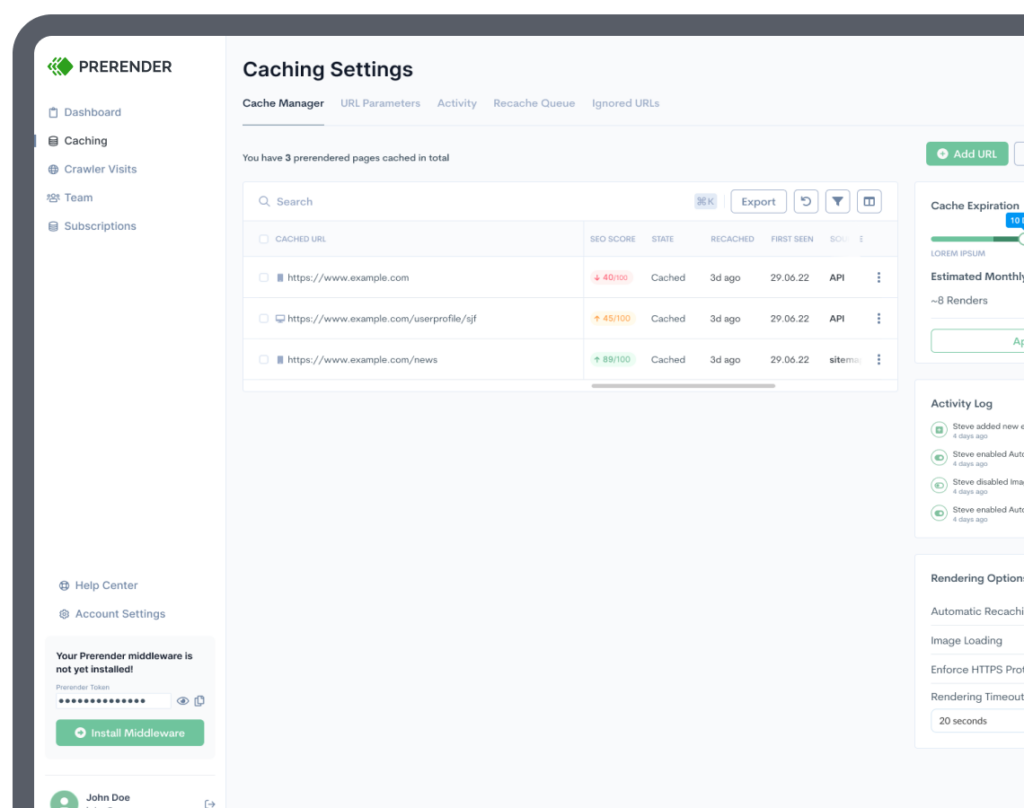ReactJS Prerendering
Get your pages in front of your ideal customers with a simple installation.
ReactJS Explained
ReactJS is well-known for its loading speed and versatility. This framework allows you to create highly interactive experiences that keep your customers engaged and convert visitors at a higher rate than basic static pages. To help your ideal customer find your dynamic pages on Google, install Prerender

ReactJS Benefits
Unlike frameworks like Angular, React only changes the elements your customers interact with. Instead of loading the entire page with every click or scroll, React will only update the sections needed, delivering a fast experience.
However, it does this by delivering your content through JavaScript.
When search engines ask for your page, it’ll send a document with only JS snippets (components), which must be executed before search bots can see any links, texts, images, etc. JavaScript makes it almost impossible for search engines to access your content, leading to crawling and indexing issues.
Solving these problems used to require hundreds of engineering hours, expensive equipment and development cycles, but now there’s Prerender.
Search engines like Google, Bing, and others take longer to crawl ReactJS sites, leaving your pages out of search engine results pages (SERPs) for weeks, months, or even forever. To fix this and any other JavaScript SEO issue, Prerender downloads all the necessary elements to build your pages and renders them on its servers. This produces static HTML versions ready to be crawled and indexed.
Implementing Prerender takes a couple of hours, but you’ll experience the benefits from the start.
Prerender takes less than a second to serve your pages to search engines, boosting speed and Core Web Vitals (CWV). Since Google loves fast-loading websites, your pages stand a chance to rank faster when you use Prerender.
Crawlers can’t follow links they’re unable to find, so Google needs to render each page before discovering and following its links. This can lead to a wasted crawl budget and a huge number of unseen URLs. By serving the HTML version of your pages, Prerender ensures that Google can spot every single link, allowing it to optimize and use your crawl budget more efficiently.
You worked so hard to write, design and develop your website. Why let all that effort, time, and money go to waste? With Prerender not a single image, text, or element is missed by search engines. Unlike other solutions, Prerender takes care of the entire rendering process (including 3rd-party JavaScript) and serves a fully-rendered and functional HTML page to guarantee the 100% indexing of your content. Get started free today!

“With over 1 million pages within the US and another 500,000 in Canada, Prerender helps our sites get crawled faster, and helps with our visibility for potential clients on search engines. Choose Prerender to aid with issues rendering your web pages.”
Donald O’Connor
Technical SEO Analyst
ReactJS makes your website more interactive and useful for your customers, which translates into higher trust and conversion rates.
Stop worrying about search engines’ limitations and allow Prerender to unlock your site’s full potential. Get started with 1,000 URLs free.

All your ReactJS questions answered.
Google’s indexing process has three steps:
React complicates the rendering step whereas Prerender eliminates that issue.
To handle JavaScript, Google needs more time and processing power compared to static HTML files, which can deplete your crawl budget faster.
This bottleneck creates a domino effect, causing missing content, low page speed scores, and in many cases, URLs getting ignored from the index.
No, dynamic rendering won’t cause any penalties on your site as it is a Google-approved solution to help search engines index JavaScript websites. This misconception comes from confusing dynamic rendering with cloaking.
In simple terms, cloaking is a black hat technique that provides an entirely different page to search crawlers and humans to mislead search engines into ranking pages where they shouldn’t. Prerender, on the other hand, renders all your content before sending it to search bots without changing any element.
With Prerender, you’ll have immediate time to value (TTV), as technical SEO results can be gauged in as little as days to a week after the implementation.